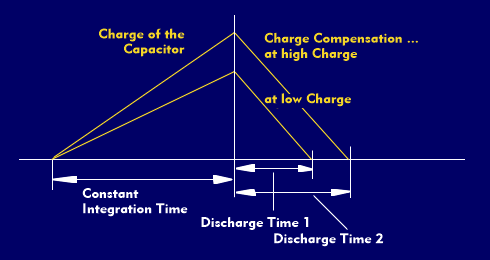dual slope methode
For the digitization of analog signals, there are several converter processes that differ in the conversion speed, quantization, coding and resolution. The dual-slope method is a modified slope method and belongs to the slower methods of the A/D converters.
In contrast to the slope method, the dual-slope method works with two slopes, which are slowly rising or falling edges. Such linear slopes are generated by loading capacitors. To achieve an exact linear function, capacitors are charged with constant current. In the dual-slope method, a capacitor is charged by an analog input voltage during a constant integration time. The charge of the capacitor is thus in a fixed ratio to the input voltage. After completion of the integration time, a counter voltage is applied to the integrator, which discharges it again in proportion to time, down to a level of zero volts. The discharge time of the capacitor is therefore a measure of the input voltage. A higher input voltage results in a longer discharge time, a lower input voltage in a shorter one.
To measure the discharge time as accurately as possible, it is used as the gate time. In the gate time, short duration clock pulses are fed to a GLUE (General Logic Unit Expansion) logic with counter, which counts the clock pulses and derives the value for the input voltage. Similarly, as with the slope method, one could use a comparator that allows clock pulses to pass at a predefined slope voltage, which are counted in a counter.
A/D converters that work according to the dual-slope method are relatively slow and are used in digital multimeters, among other things. Their accuracy is around `10^-4`. The resolution of dual-slope converters is relatively high and may well be 16 bits or more.

